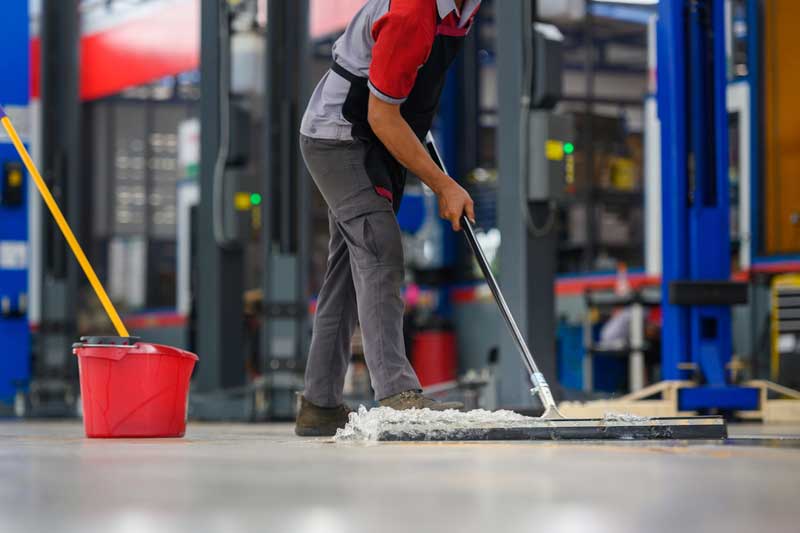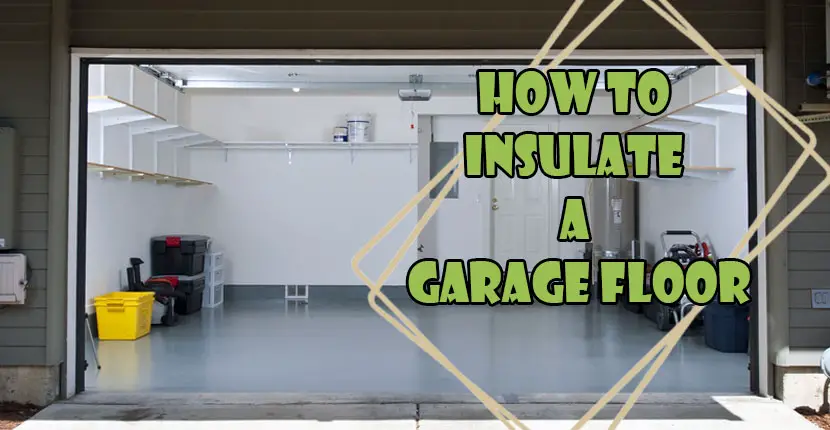If you’re planning on making your garage more comfortable and energy-efficient, it may be a good idea to insulate the floor. Most would start off with the walls and ceilings. While it may be worth doing so, the floor is often forgotten.
Nevertheless, insulating the garage floor will be great for when you want to keep the place warm in the winter. Especially if you are using a space heater. Likewise, you may also have plans to keep it cool in the summer.
It’s no secret that your garage is a great place to work or spend time in. So it would make sense to make it as comfortable as possible. Now, let’s take a look at the following steps below that will help you insulate a garage floor with ease.
#1. Clean and Prepare the Floor

Before you begin with the insulation process, you’ll want to clean and prepare the garage floor. You’ll want to remove any items such as tools or vehicles. You’re going to need plenty of room for you to insulate the entire garage floor.
It would be a good idea to sweep or vacuum the floor to ensure there is no dirt or debris. If you notice any cracks or holds on the floor, you’ll want to fill them in. You can use concrete patching compound to get the job done.
You’ll want to make sure that it’s dry completely prior to moving on to the next step.
#2. Choose Your Insulation Material
There are several types of insulation materials you can use to insulate your garage floor. They include fiberglass batt, spray foam, and foam board insulation. Each type has their own advantages and disadvantages.
So it may be a good idea to consider which ones will fit your personal needs and preferences. If you’re stuck on which type to choose, you can never go wrong with foam board insulation. It’s a popular choice for garage floors since it’s easy to install and provides you with excellent insulation value.
This type of insulation comes in large sheets. However, you can cut to fit the size and shape of your garage floor.
Fiberglass batt insulation may be a great alternative option. The installation process will be a bit more challenging compared to foam board. You’ll want to cut the batts to the size of your floor and lay them between the joists located under the floor.
If you have a bit of money to throw around, spray foam insulation may be another good option. You get the best value in terms of insulation. Yet, it’s also one of the most challenging forms of insulation to install.
It may be so difficult that you may need special equipment to apply it. Otherwise, you may need a professional to install it for you for a fee. If you don’t want to deal with a ton of hassle regarding the installation process, you can choose the foam board insulation options.
If you’re a complete newbie to DIY, it’s always a good idea to select the insulation that will be easiest to install.
#3. Install a Vapor Barrier
Another thing to install before the insulation is a vapor barrier. The purpose of this is to prevent moisture from seeping up through the floor. There are vapor barriers specifically made for garage floors.
Alternatively, you could use a sheet of plastic. A vapor barrier can be very effective and for many reasons. To install a vapor barrier, you will need to lay it over the entire floor.
You need to make sure it extends up the walls by several inches. Trim the vapor barrier with a utility knife to where it can fit the size and shape of your garage floor. Lastly, you’ll want to tape any seams or overlaps with duct tape.
#4. Install the Insulation
Now, we get to the fun part. After the vapor barrier is installed, it’s time to install the insulation you chose. Let’s take a look now at the following installation steps based on the type of insulation that you’ve chosen:
Foam Board Insulation
First, you’ll want to simply cut the sheets to ensure that they fit the size and shape of your garage floor. Next, lay it on top of the vapor barrier. Make sure that it is nice and secure and don’t leave any gaps behind.
Fiberglass Batt Insulation
As mentioned, this will be a bit more challenging compared to foam board installation. You’ll want to cut the batts down to the exact size and shape of your floor. Secure the insulation between the joists.
Again, make sure there are no gaps left behind. This can lead to leakage of air coming from the outside. Thus, it would defeat the entire purpose of keeping your garage warm and well-insulated during the colder months.
Another thing to remember is that there may be various rodents and pests that may gain access into the garage. One more reason why you need to seal off any gap you can.
Spray Foam Insulation
This is a type of insulation that should be installed by a professional. That’s because it requires special equipment and it needs to be installed properly. This will not be a good option for those intending to go the DIY route.
#5. Install a Subfloor
After the insulation has been installed, you’ll want to install a subfloor over the top. You’ll want to give your garage that smooth surface level floor. Not only that, you’re going to need it for protecting the insulation from any damage.
Like insulation, subfloor materials come in various types. They include but are not limited to plywood, oriented strand board (OSB), and high-density polyethylene (HDPE) panels. You can choose plywood and OSB as your best options since they are readily available and the easiest to install.
To install the subfloor, you want to lay the panels over the top of the insulation. Next, secure them in place with screws and nails. You’ll want the panels to be flush with the walls and each other.
You can leave a small gap around the edges so it can allow for expansion.
#6. Finish the Floor
With the subfloor now installed, you can finish the floor with your favorite material of choice. You can paint it or epoxy the garage floor. Whatever you choose, you need to make sure that the surface is durable and easy to clean.
If you intend to use your garage as a workshop or a place for heavy duty activities, you may want to add a layer of cushioned flooring on top of the subfloor. This will reduce any instances of fatigue and make it more comfortable.
Once the floor is finished, you now have a garage floor that is fully insulated and newly renovated. You can take a moment to marvel at your latest DIY project.
📚 Related: Things You Need To Update Your Smart Family Room
What Are the Benefits of Having an Insulated Garage Floor?
There are several different benefits you can enjoy when you have an insulated garage floor. Here’s what they are:
Increased Comfort
There’s no denying that your garage floor will be insulated to the point where it’s at a comfortable temperature inside the garage itself. The more comfortable it is, the better it will be to work in the garage – especially during the colder months.
Energy Savings
Insulating your garage can reduce your energy bill. This is done by preventing heat from escaping through the floor. This may be a huge benefit for those who have a garage that is attached to their home.
Likewise, if it shares a wall with a heated living space, a garage will benefit from an insulated garage floor.
Reduced Moisture and Condensation
Of course, there is no greater benefit quite like the reduction of moisture and condensation. The reason for this is that it will deter any mold or mildew growth that can occur. Needless to say, it can spread fast to the point where it can damage the structure of your garage (and even your entire home).
Another thing that you’ll enjoy is that you can store various items. Especially the types of items that are sensitive to moisture like paper or wood products.
Improved Soundproofing
If you want to reduce the noise transfer between your garage and home, then insulating a garage floor might be the best option. This can be useful when you’re going to be quite a bit of work in the garage itself.
At the same time, it will also reduce noise that may disturb the others living in your house.
📚 Related: Turning Old Door Into Sliding Barn Door
Final Thoughts
If you are looking to insulate a garage floor, you now have a few reasons to do so. Just make sure that you have the right materials to start. Also, consider what options you have in terms of how you want to install it.
There’s nothing quite like a garage that can stay comfortable, even on the coldest days. Give this project a try today and see how it works out for you. We hope this guide has been super helpful.

